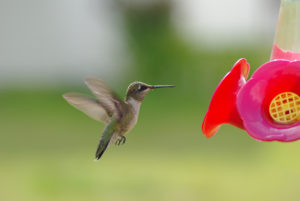
The month of May is when I expect to see hummingbirds return to central Indiana. I find the migration map from HummingBirdCentral.Com is helpful for determining their locations.
My wife jokes about my hobby, and alerts me of their presence.
Your hummingbird, Patrick, is here to see you…
I became interested in feeding hummingbirds after I purchased a new Pentax K-series digital camera. I needed something around the house to photograph, and found these birds offer a wonderful challenge for an amateur photo enthusiast like myself. Feeding hummingbirds is now just a part of my regular routine
Today, I prepare for their return.
Because traces of mold could be seen in the feeders that sat over the winter (and that’s bad for the hummingbirds), I soaked the glass feeders in a sink full of warm water with a little chlorine bleach for about fifteen minutes. I also used and old soft tooth-brush to help scrub everything sparkling clean. Rinsing all the bleach solution out thoroughly is just as important since even a little bleach would be terrible for a tiny hummingbird.
I soaked all the brightly colored plastic parts in a 25% vinegar/hot water solution instead of bleach to prevent discoloration. The vinegar is also easier to rinse off plastic so there’s no lingering bleach smell which alleviates my paranoia of mixing bleach with hummingbirds.
Your Basic Sugar Water Recipe
- One cup of sugar
- Four cups of water
A good hummingbird feeder solution is one cup of granulated sugar to every four cups of water. One US gallon = 16 US cups, So, to make a gallon, you simply mix four cups of sugar into each gallon of water. This makes enough to fill an empty gallon jug with a little left over to use for that day’s feeding.
Never use a sugar substitute or artificial sweetener.
Don’t worry about the color of the mix — or — lack thereof.
Adding red dye to the recipe is unnecessary and largely discouraged. Many feeders are already brightly colored red, which attracts hummingbirds. Even without the bright red colors, hummingbirds will still find the sweet sugar filled feeders.
Maybe more important than color, I noticed hummingbirds seem to prefer cane sugar to beet sugar, so I’ll skip the cheap stuff and go straight for the Domino brand. Hey, with all the other feeders in the neighborhood, I have to have an edge. Either type will work though. Just make sure to only use pure white granulated sugar. Anything else, is probably deadly to hummingbirds.
I have a couple of feeders and I like to change the feeder nectar each morning. So, I’ll typically make a gallon of hummingbird food on the weekend and keep it refrigerated in a marked container for use throughout the week. I prefer to boil the feeder water on the stove-top which is said to help extend it’s shelf life and helps remove the chlorine from the water. Adding the sugar to boiling water also helps the sugar dissolve. Once cooled, the humming-bird feeder solution can be transferred to a suitable container and stored in the fridge for up to two weeks.
While it might sound like too much of a chore, I’ve become so accustomed to all the hummingbird activity in the yard over the years, I doubt summer would be the same without them.
Check out my hummingbird set on Flickr to see more pictures of Patrick.
Photo Credit: cbede, Flickr Creative Commons Attribution License.
